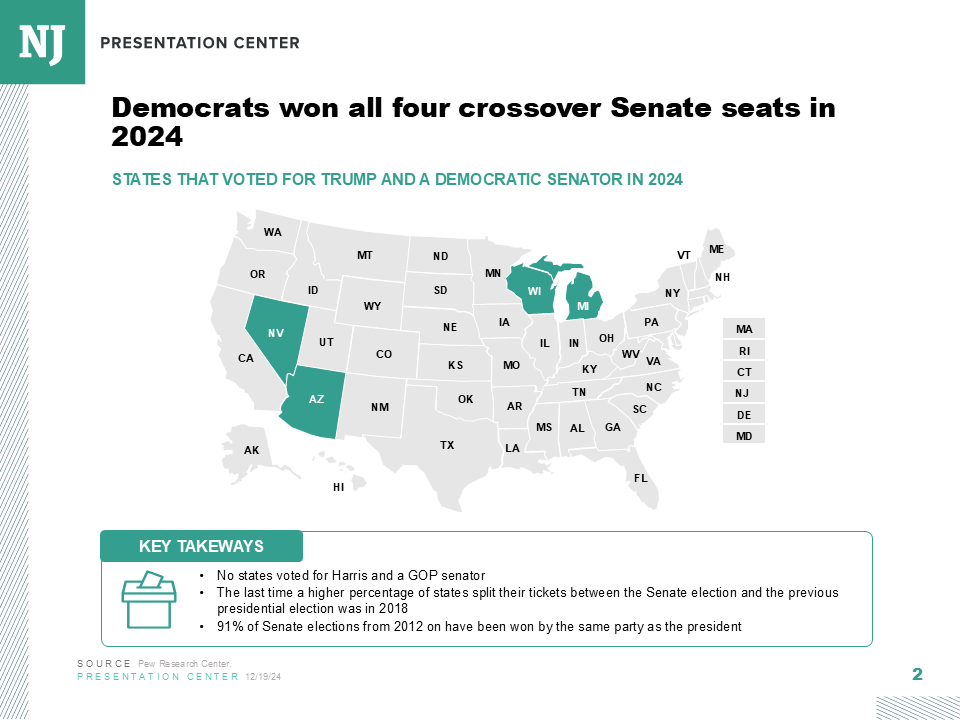Expect a torrent of new polls coming out over the next week in advance of President Trump’s 100th day in office next Wednesday. Most are likely to present numbers that should cause heartburn for party strategists and operatives.
The partisan spin will be predictable: Republicans will point to the Democratic Party’s favorability ratings being so badly underwater as to almost be in Titanic territory. To put it in perspective, in last month’s NBC News poll Elon Musk’s positive ratings were 39 percent, 12 points above those of the Democratic Party at 27 percent. The tech mogul had a 51 percent negative rating, 4 points below Democrats’ 55 percent. Musk’s numbers netted out to negative 12 points, Democrats to a negative 28 points. Not that the GOP’s numbers are great, at 39 percent positive and 49 percent negative, but it’s a good sight better than that of the opposition.
The GOP spinmeisters will also point out that Trump’s approval ratings are running above where they were in 2017 (though the improvement is slight, usually only 2 to 4 points higher).
Democrats will point to Trump’s dropping numbers on bread-and-butter issues like the economy, his strong suit in his first term. But his decline isn’t nearly as precipitous as his critics would like. The reality is that there are roughly 4 in 10 voters who will approve of anything he does, details or news be damned. With that solid of a core, it limits how far and how fast numbers can drop. When President Biden’s numbers plunged between June and July 2021 as inflation started spiking, he didn’t have the same militant base that would insist that there was no such thing as inflation or that it was a good thing, helping people negotiate higher salaries or something.
Each party has liabilities, enough that should any of them become the focal point in the public’s mind, that party has a real problem. But in the upcoming midterms, one of the biggest variables may well be which nominees emerge from party primaries.
In 2022, Democrats were able to overperform Biden’s awful approval ratings because GOP primary voters opted to nominate some awfully exotic candidates in critical races, enough to turn what should have been a pretty good night for Republicans into a real disappointment. Those primary misfires may well have cost the GOP Senate seats in Arizona, Georgia, New Hampshire, and Pennsylvania; governorships in Arizona, Michigan, Pennsylvania, and Wisconsin; attorney-general contests in Arizona, Michigan, Nevada, and New Mexico; and secretary-of-state races in Arizona, Michigan, Minnesota, and Nevada. Then of course there were congressional races in the at-large seat in Alaska, Michigan’s 3rd District, North Carolina’s 13th District, New Hampshire’s 1st District, both the 9th and 13th districts of Ohio, Virginia’s 7th District, and Washington’s 3rd District. An overenthusiastic party base can easily turn a strong chance for a gain into an opportunity lost.
The GOP has been wrestling with these demons for more than a decade. In 2010, GOP primary voters in Nevada nominated tea-party favorite Sharron Angle, costing the party a chance to beat Harry Reid, the Democratic majority leader at the time, whose polling numbers were in the danger zone. In Delaware, another tea-party-style candidate, Christine O’Donnell, who found the need to say in an ad that she was not a witch, upset a more moderate and traditional Republican, Rep. Mike Castle, effectively handing the race to Democrat Chris Coons. It happened again two years later, when GOP primary voters in Indiana chose Richard Mourdock over Sen. Richard Lugar, and Republicans in Missouri picked Todd Akin, complete with his rather unusual attitudes about rape and pregnancy, over more-electable choices. That tipped the general election to Democrats Claire McCaskill in Missouri and Joe Donnelly in Indiana.
Democratic National Committee Vice Chair David Hogg would do well to learn those lessons. The Parkland High School shooting survivor has pledged to spend $20 million against incumbents to drum out the “culture of seniority politics.” That might well go over well at a street fair in Takoma Park or at a Bernie Sanders and AOC rally, but not so well in competitive states and districts.
Later this year, political aficionados can shift from looking at polls to actual votes in major jurisdictions, thanks to the odd-year gubernatorial contests in New Jersey and Virginia. Democratic Gov. Phil Murphy, having won reelection in 2021, is term limited in the Garden State. In Virginia, governors are not allowed a second consecutive term, though they can run again in a subsequent election as Terry McAuliffe attempted to do four years ago. So that seat is also open. Both races are expected to be competitive, though Democrats have an early edge in both.
Obviously, the Virginia race will get more attention in Washington, but New Jersey’s gubernatorial race features the collision of two forces. On the one hand, the last Republican to carry the Garden State in a presidential election was George H.W. Bush in 1988 and no Republican has won a Senate seat in New Jersey since Clifford Case in 1972. Only three of the state’s 12 House members are Republicans, and the GOP holds less than 40 percent of the seats in each of the two state legislative chambers.
But then again, no party has won the New Jersey governorship three times in a row since 1965. Robert Meyner, a Democrat, was first elected in 1953 and reelected in 1957; then another Democrat, Richard Hughes, was elected in 1961 and reelected in 1965. With Phil Murphy’s wins in 2017 and 2021, at least theoretically it should be Republicans’ turn to win. But that’s just theoretical.








